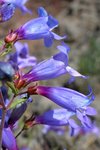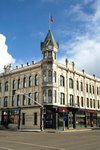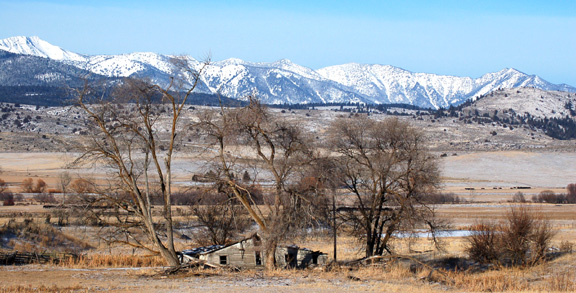- Gray-crowned Rosy Finches at the Oregon Trail Interpretive Center
- More on Corporations as Persons (Corporation Running for Congress Satire)
==============================
Gray-crowned Rosy Finches
I first encountered the Gray-crowned Rosy Finches well over 20 year ago, back in my rock-hounding days. We were exploring the Darwin Mining District in the Darwin Hills of Inyo County, California when we encountered a gray, brown and pink bird that was apparently roosting in the old mine shafts. A check of the old Audubon bird guide showed them to be Gray-crowned Rosy Finches. That was my last confirmed visual sighting until yesterday.
Gray-Crowned Rosy Finch
 Rosy Finch on railing in front of Interpretive Center.
Rosy Finch on railing in front of Interpretive Center.Gray-crowned Rosy Finches, while widespread, are uncommon and rarely seen. If you subscribe to the OBOL (Oregon Birders On Line) list or the birding list out of EOU in La Grande, you will read occasionally of sightings, usually in the country north of Wallowa, but sometimes east of Cove near La Grande. Thats a long trip for a long shot sighting, so local birders were pleased to find out that the Gray-crowns had been sighted in front of the Oregon Trail Interpretive Center before Christmas. Interestingly, I first heard that the birds might be there from some none-birding friends visiting from Elgin around New Years. A call to Cheri, who woman's the front desk at the center, confirmed that they were showing up periodically, and had been since around late November.
A few of us made separate visits to the area, including the front entrance to the center, off and on for several weeks without success. Then last week, Sheri saw them again in late afternoon, and they were seen around the same time for several of the succeeding days. Finally, yesterday's visit paid off. After no luck initially while hiking around the center, I went in to speak with Cheri. She said it was about 4 minutes before the time they seemed to be showing up--3:40 PM. I went inside to poke around and 2 to 3 minutes later they appeared. Unfortunately, about the same time, they were immediately scattered due to the fact that the resident Kestrel (sparrow hawk) came looking for dinner. (Two are known to have crashed into the front windows this winter with one fatality--wondering if they were trying to escape the Kestrel?) about 5 or 6 came back briefly and the left seemingly to the back of the building. After trying to find them again, around the building, I noticed one lingering on the railing in front of the building. After I got back up there, it remained long enough for a very short photo session. Due to the calm, half-tame nature of the birds, I was able to get close enough for a decent photo prior to its flying off in search of its friends.
My feeling is that because these Rosy Finches have an affinity for rocky hillsides and talus, both found at the Interpretive Center, and are known to roost communally during winter in mine shafts (of which their are several in the area), bridge supports (like supports found below the building) and buildings, they are likely showing up in the late afternoon to be close to their communal night-time roost.
Primary area to find the Rosy Finches (Dirt is on the lens, not the building!)
 Finches, when present, are usually on the railing, supports, or rocks near the walkway.
Finches, when present, are usually on the railing, supports, or rocks near the walkway.More about these finches
The three North American species of Rosy Finches, the Gray-crowned, Brown-capped, and Black Rosy Finch, were once considered to be a single species, but have since been separated back to the three individual species. Within the Gray-crowned species, there are 3 or 4 subspecies. The birds at the Interpretive Center appear to be the Gray-cheeked or Hepburn's subspecies, but the Audubon Society of Portland recognized the Gray-crowned Rosy Finch population that is endemic to the Wallowa Mountains and surrounding area as a separate subspecies, the Wallowa Rosy Finch. As the Hepburns and Wallowa subspecies closely resemble each other, at least according to Gabrielson and Jewett, and intermingle on their N. E. Oregon wintering grounds, I can't say with any certainty which subspecies the Interpretive Center's birds belong to, although it is likely a Gray-cheecked/Hepburn's, due to their higher numbers.
To see the Wallowa subspecies alone in its breeding range, one must travel to the alpine zone of the high peaks in places like the head of Big Sheep Creek or the summit area of Brown Mountain. (See the chapter on these birds in "The Birds Of Oregon, by Gabrielson and Jewett, 1940, reprinted as Birds of the Pacific Northwest in 1970.) There they describe their chilly summer breeding grounds:
"The habits of this small finch have made it a species of peculiar interest to ornithologists. It seeks the cold and austere heights for its summer home and there, about the perpetual snow and ice, builds its nests in crevices and crannies in the rocks and forages for food on the surfaces of the snowfields and glaciers. [where] they feasted on chilled insects that had fallen benumbed on failure of their endeavors to cross the frozen areas."
If you would like to see one of these attractive and uncommon finches, late afternoon at the Interpretive Center entrance is your best bet. Remember that there are no guarantees and that their visits, in groups of 5 to 20, have been sporadic since late fall. It is likely that they will be heading back up toward their breeding range before long, especially if the weather stays unseasonably warm. If you head out that way, remember they close at 4 PM.

Learn more about these finches:
All About Birds/Cornell Lab of Ornithology
http://www.allaboutbirds.org/guide/Gray-crowned_Rosy-Finch/id This site shows the "Interior" subspecies, which lacks the large gray cheek of our birds.
Birds of North America Online
http://bna.birds.cornell.edu/bna.html/species/559/articles/introduction
BirdWeb
http://birdweb.org/birdweb/bird_details.aspx?id=453
California Department of Fish and Game
nrm.dfg.ca.gov/FileHandler.ashx?DocumentVersionID=17741
From the Morgue

As mentioned above, a few weeks ago a Rosy Finch flew into one of the large windows at the entrance and died. The Bird Conservation Network estimates that "At least 100,000,000 [that's one hundred million] birds are killed and even more are injured every year across North America by collisions with windows." (http://www.bcnbirds.org/window.html)

Some of these deaths can be prevented if a pattern of some sort can be placed on your clean, clear wndows. My persoal solution, that seems to work well while fitting my character, is not washing them. ;-) Let that film and spotting thicken up a bit! Not quite the same as a decorative film, but it is effective and economical.
The Bird Conservation Network Recommends:
"Reflective Windows: Put something on the outside of the window to alter the appearance of the entire window. The coverage must be total and allow for openings no larger than 4 inches (10 cm) across.
Options:
1) Hang strips of 1+ inch wide paper / ribbons / string / mobiles every four inches
2) "Frost" or "etch" the glass using techniques popularized by decorating books and websites
3) Sponge or stamp on a decorative pattern with soap or thinned window paint
4) Cover the windows with "CollidEscape" perforated film to make windows visible to birds while allowing those inside clear view to the outside
5) Cover the window with decorative films"
If you do find or receive a dead bird, not one legally hunted of course, be sure to call ODFW to see if you can legally possess it. Besides non-natives like house sparrows and starlings, it is generally unlawful to possess native birds without a permit.
______________________
More on Corporations as Persons
--
(Murray Hill Incorporated is Running for Congress Must See Satire!)
Click Here: http://www.youtube.com/user/murrayhillcongress#p/u
_______________________
Edwards says Amend the Constitution
On January 27, 2010, Congresswoman Donna Edwards announced that she would introduce an amendment to the U.S. Constitution to undo the damage caused the the Supreme Court's ruling in Citizens United v. FEC.
http://www.youtube.com/watch?v=ysUr0fj3aRY
Join this effort:
http://freespeechforpeople.org












2 comments:
For an alternative point of view one won't find on this blog, see:
http://online.wsj.com/article/SB10001424052748704094304575029791336276632.html
Why should CNN, Fox, and MSNBC be the only corporations who have first amendment rights?
And don't forget that non-profit corporations have the same privileges that the for-profit ones do.
Democracy demands a marketplace of ideas, and free speech is the foundation of that marketplace.
From Christopher Christie's email to me after my last post:
". . . promoting your self as "Moderator" seems a bit fraudulent, dishonest and cowardly, don't you think?
Chris"
Why doesn't Chris comment on the substance of my post instead of questioning my character?
Post a Comment